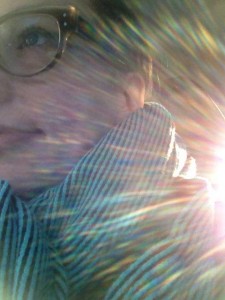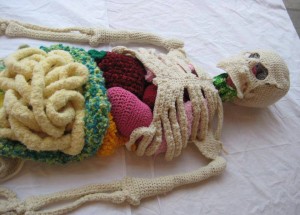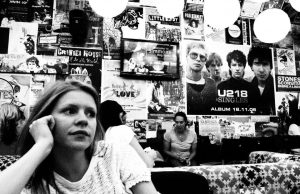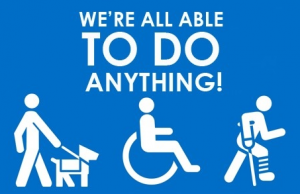Disability Made Visible
By AMarie Houser
Your partner touches your arm, your shoulder: his fingers like pebbles, alluvial strikes. Waves of pain radiate from the small pressures. Your muscles constrict; toes are painful in their shoes.
Twenty-seven, and you feel a kinship with the white-haired in the doctor’s office. You have stopped eating because food sits, undigested. You tilt your head to swallow back vomit. Remember the party tricks five years ago? Ask for a five-dollar bill, put it under your foot, do a back bend. Bend so far your head meets your heel; pull the money out with your mouth. You’d tire, tunnel under the guests’ pile of coats, curl into sleep.
Now exhaustion abides, but sleep withdraws. Sometimes, sitting or riding a bike, it’s as though someone reaches inside and twists: you collapse, folding over. You floss and dislocate your jaw. A femur gives out when you walk. Then again. Then you fall down a stair, break vertebrae.
Life becomes horizontal, pain and confusion ratcheting out from the center of you. There is a center to you.
One by one, you quit whatever surpasses need, whatever is extra to existence. You compose yourself for school — a drag, a dread – where phrases ping the hallways: fragmented, shifting identities…decentered subjects… You had become alarmed with cultural theory’s appropriation of disability. But you don’t quite recognize illness as a genus of you.
You are a raft, scattered notes around your head, your body, like missives from drowned lovers: What day is it? Month? Driven into your body, ground into an experience of it, the notes around you are clouds: they spell the successive dreams of Western thought since Descartes, flights from material experience into mind, into language, into the self as discursive, relational.
You didn’t quit so much as disappear. The knowledge of you is a chemical taste on your tongue.
###
Five years passed, ten. Diagnoses accumulated, often diagnoses of exclusion, and I came to expect alleviation rather than a cure. The tests hadn’t been invented, it seemed, that could give me something to hang like a flag, identifying a sovereign state of illness. Or rather, that could give me something to alleviate the need others had of me: that it be knowable, comprehensible, and above all, fixable.
“You scare doctors,” the M.D. writes in a blog post[i]. “No, I am not talking about the fear of disease, pain, or death…chronic unsolvable disease stands square in our way. You don’t get better, and it makes many of us frustrated, and it makes some of us mad at you.”
He writes, “I am not talking about doctors being afraid of the limits of their knowledge” – but that is precisely the case. An unsolvable illness marks a shifting shore, redrawing itself, chewing up the edges.
Rate your pain from 1-10. What is seven? Two? Five, I’ll just say five. Five. Are you sure? Three was what was bearable before this became chronic. Now three is maybe five to six because ten is frequent, but it all seems like a loaf of bread, a spectrum of small difference. Indicate if your pain is sharp or dull. It hums. It reverberates. So, dull. Yes and no. There are small jolts, like hummingbird beaks meeting the membrane of my skin. Just answer ‘yes’ or ‘no.’
Beyond ten, and I swear, cry, or go blank. One day I was silent, to which the doctor responded in a report, “Affect was flat.” When I am exhausted, words become like Platonic forms I cannot find my way through, cannot meet or match. I trip up. I despair. Another report said, “Patient is anhedonic.” I’d try to drink coffee before appointments, because it occurred to me that the glummer I seemed, the more impatient a doctor became – but I’d only become jittery, sped up, nauseous. “Patient is anxious. Patient has a number of psychosomatic complaints.”
Nothing could have been more certain to me than that my body had radically altered, something fundamental, something through which pain spoke; little else about me could have been less certain to others.
How do you know it’s not depression, a friend said. Try yoga. Are you seeing a therapist? An acquaintance said, If you’re in pain, why did you come to the party? A mutual friend said, You can’t say you’ll come to her party and then not show up. Another person said, I know I can help you, if you’d just let me. Think positive thoughts! The mind is connected to the body, which means, every mystery of the body is now a suspicion of the mind.
###
 You are thirty-nine. Pain now abides. It articulates another body, or perhaps a map of concern. This map, you understand, will keep unfolding, as the waves unfold under a ghost ship, redrawing themselves into new shapes.
You are thirty-nine. Pain now abides. It articulates another body, or perhaps a map of concern. This map, you understand, will keep unfolding, as the waves unfold under a ghost ship, redrawing themselves into new shapes.
And you are enchanted by your own disappearance inside the largeness of pain. This disappearance is not fragmentation, but expansion: pain begins beyond your fingertips, goes into your fingers and hands, up along your arms and into your shoulders, shivers, shakes itself off, dispersing into air like water or sound, becoming larger and larger.
She is a hand therapist, the sixth or seventh physical therapist in a decade, each one specializing in a different issue in a different part of the body, like pelvic floor disorder. She says you have severe bilateral carpal tunnel, and the surgeon agrees, so you agree to surgery. It cuts the ligaments in both your wrists.
At home you stroke your cat with bandaged palms, nodding off. Oxycodone is like no other medication you’ve tried: the inside of a fall forest, the atmosphere so clear that one moment stretches out on an infinite plane. No shores, no waves, no retraction. You have never felt this released.
You are too enamored with the opioid nod, and have been assured of a 98% rate of recovery. So you throw away the pills. Recovery does not come.
###
After the surgeries, I fainted. Then I fainted again. My partner spotted me while I showered. I developed a sense of the world whooshing, a vertigo that kept tilting my head down.
The orthopedic center had a success rate to maintain. The occupational therapist that worked under the surgeon cycled through explanations, trying to hit the right one: I must not have been doing the exercises. I must not have been doing them correctly. I wasn’t wearing the arm splints at night, which were meant to calm the pain in my elbows. The last was right: the material she’d fashioned them from, sheets of polymer, was too heavy and too long for my arm bones. When I’d roll to my side, my shoulder would pop out.
I had enough. I was, finally, unwilling to do the emotional labor of helping health professionals through their uncertainty, an emotional labor I had performed in the first place by returning to appointments, and in the second place by smiling, nodding, and asking questions rather than challenging assumptions. Those follow-ups were my implicit assent to the explanations that they often came up with just to have explanations.
I found a research center and a doctor whose comportment was one of care and attentiveness. He noticed. He touched my fingers, which taper at the ends and curve up from the joints at rest – something I had not noticed. He looked at the small bulb of my nose, noted my wide eyes and small head. This attentiveness gave way to questions that were guided by the language of my body: what happens when you bend over? Can you touch the floor? Yes, it seemed you could. Would you mind if I tried to bend your thumb to your—wrist, there it goes.
At forty, then, I am told what I have, what I am: I was born with Ehlers-Danlos Syndrome, “a group of hereditary connective tissue disorders characterized by defects of the major structural protein in the body (collagen).” Collagen is “a tough, fibrous protein” that “plays an essential role in holding together, strengthening, and providing elasticity to bodily cells and tissues.” That leads to “primary findings” of “abnormally flexible, loose joints (articular hypermobility) that may easily become dislocated; unusually loose, thin, stretchy (elastic) skin; and excessive fragility of the skin, blood vessels, and other bodily tissues and membranes.”
The doctor explained that my pain syndrome is secondary to EDS. The laxity in connective tissue gives room for nerves to jangle, he said; the lack of ligament strength means muscles have to do the job of stabilization. He noted that the diagnosis often comes as a relief to patients, who are routinely dismissed by professionals who do not recognize the signs. But I don’t regard EDS as the only etiology for pain, GI dysfunction, and dysautonomia. Pain is considered in some specialties to be a brain disease; as such, it involves altered pain processing and perception that accords with findings of chemical, functional, and structural brain changes.
###
For some people, life is a movement from bodily certainty or assurance to the removal of that certainty through dying and death. The body begins a given. It is ground, a place from which to proceed, except in moments when materiality asserts itself – cramps, allergies, stool habits, giving birth. Pain shakes that ground; chronic pain opens up a fault line, and another, and the maps get redrawn. This is how I conceptualize my experience, knowing that other experiences of disability begin and end quite differently.
I catalogue my history, resurrecting the particulars, because it’s the only way I know how to authentically materialize the body within disability theory. I admit that I mistrust texts that begin with the admission, “I have a disability,” without saying something about the experience: critical theory above all is not neutral; we come to these issues with a stake in them. People with “invisible” disabilities have a stake in asserting the bodily side of mind-body, to think through disability as corporeal. We nudge towards exteriority, scaling the outer rings of our mysteries, hoping to find others recognize us there. Because such disabilities are not identifiable to others by ready use of their senses, communication becomes that much more important. But pain levels verbal communication, distorts it, whereas verbal communication is privileged over bodily communication – one of the legacies of rationalism. In social and legal spheres, invisible disabilities can be easily dismissed, especially when they are classified as mental illnesses, displaced by endless questions of fact or facile psychologisms.
I insist on the materiality of my disability and, at the same time, I understand that it gets caught up in social meaning: disability arises out of the body meeting social conditions. Chronicity, which I take to be one of the key material conditions that distinguishes “disability” from “impairment,” can arise when illness or impairment is undertreated because of unequal access to healthcare and biases within medical practice. Research has shown disparities in treatment for women, people of color, and non-native English speakers – foregrounding the need to continue to work critical disability theory into other oppressions, and vice-versa. But we should be wary of simply binding up disability with other oppressions under the sign of ableism, such that ableism means everything and nothing.
Equipment use is often metonymic for disability. The problem with this metonymy – and I’m thinking of the international sign for access – is that it can delegitimize less obvious forms of disability, rendering “disability” as that which is knowable, comprehensible, and “fixable.” Images of athletes in wheelchairs get used for a new kind of ableist normativity, one of disability that overcomes itself, calling into question “disability” and reasserting ideals of virility and strength. And these images, paired with captions like “The Ability in Disability,” set up unreasonable expectations for the persons photographed – that they should function like oracles, otherworldly beings who survived the worst that could happen — as well as for persons whose disabilities equate to a lack of energy, a lack of strength.
Despite persuasive theorizations like Alison Kafer’s that “claiming crip” – a reclamation of the pejorative “cripple” — “can be a way of acknowledging that we all have bodies and minds with shifting abilities,” I reject the crip appellation for myself (p. 13).[ii] When Kafer writes about its meaning as extending to invisible disabilities, inclusive of them, I understand that my disability gnaws at the edges of what crip means. If I am included, it’s because I am given a benefit — the benefit of doubt.
If I have one certainty, it is my body, my own body, myself. The knowledge of me is a chemical taste on my tongue.
[i] The letter was originally a blog post, but now appears at http://www.igliving.com/Assets/IGL/eMagazine/IGL_2013-10_Online-Issue/files/12.html
[ii] Kafer, Alison. Feminist, Queer, Crip. Bloomington: Indiana University Press, 2013. Print.
__________________________________
 AMarie Houser is a writer, editor, and explorer of wilds and nonhuman worlds. Her creative work has appeared in various print and online journals. She has been lucky enough to receive grants for her writing and performance art.
AMarie Houser is a writer, editor, and explorer of wilds and nonhuman worlds. Her creative work has appeared in various print and online journals. She has been lucky enough to receive grants for her writing and performance art.





Pingback: Afterword: The Disability Forum - The Feminist Wire | The Feminist Wire
Pingback: weekly reads: 2013 is the year of the queers and here are some links to celebrate that « Delete the Adjectives